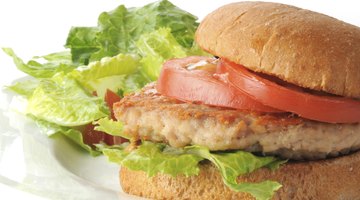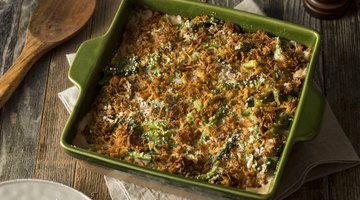
Spiral-sliced ham was as welcome a food invention as sliced bread. Hacking through an un-spiraled ham on the buffet table at holiday time was a mess, and diners often ended up with chunks, not evenly cut slices. Now that we're living in the modern age of ham, heating spiral sliced ham for the buffet table takes minutes, not hours, and it always gives us evenly cut, fully carved slices. The best way to reheat a spiral sliced ham to keep it moist during the heating process doesn't require much skill, only a meat thermometer and a kitchen timer.
Maintaining Moisture
As you unwrap your pre-cooked ham, juices flow out. That juice is lost moisture, so use it on the bottom of your roasting pan. If you don't have much juice, add some chicken stock to the pan to create a shallow pool. That's the best way to keep a spiral sliced ham from drying out while reheating.
Rewrap the ham with heavy-duty aluminum foil, making sure the foil is tight around the ham. You don't want any heat to escape from the ham itself and cause it to dry out. If the ham comes wrapped in foil, don't unwrap it.
Reheating a Cooked Ham
Since the ham you've purchased is already cooked, reheating the spiral ham and making it look and taste exceptional are all it takes to dress up your table. Remove all the packaging, and if there's a glaze packet, set it aside. Let the ham come up to room temperature before putting it into the oven.
- Place the ham, face-side down, in a roasting pan and cover tightly with heavy-duty foil.
- Slide a second pan filled with water into the oven underneath the rack where the ham is placed.
- Set the temperature at 275 degrees Fahrenheit, and when the oven is up to temperature, heat for 10 minutes per pound.
- Be sure your meat thermometer reads 140F before removing the ham from the oven.
Glazing Your Spiral Cut Ham
Some hams come with a glaze packet, but if you're going for a special taste, make your own. A favorite is to mix brown sugar and maple syrup thoroughly and add a dash of Dijon or American mustard. Use a pastry brush to cover the ham with the glaze and then return it to a heated 400F oven for 10 minutes, or until the glaze bubbles.
Using a Slow Cooker
Slow cooking a pre-cooked ham maintains its moisture. It's also a great way to reheat leftover ham when making a casserole. Place the ham in your slow cooker; splash some chicken broth or a can of cherry Coke over it; and roast on low for 5–8 hours, depending on the size of your ham. Leave extra time between cooking and serving time to glaze the ham.
Turn your oven to broil, cover the ham with the glaze, and broil for about 10 minutes or until the glaze starts to bubble. You don't want to overdo it and start losing the moisture you've so carefully protected during the cooking process.
Roasting in a Cooking Bag
Cooking bags have long been a good way to maintain moisture when cooking meat, and using it for a pre-cooked ham is no exception. Just be sure to splash some flour around the inside of the bag before placing the ham in it, and cut several steam-release openings in the bag before putting it into the oven.
Roast, face-down, at 250F for 10 minutes per pound, or until a thermometer placed through one of the slits registers 100F. Remove it from the oven, turn the bag down halfway, and apply half of your glaze. Switch the temperature up to 350F and heat for about 10 minutes. Swab the ham in the leftover glaze before serving.
Check Out These Thanksgiving Dinner Recipes
Gallery (24 photos)












References
Writer Bio
My seventh grade English teacher didn't realize what she was unleashing when she called me her "writer," but the word crept into my brain. I DID become a writer. Of advertising copy, dialogue and long-term story for several network soap operas, magazine articles and high-calorie contents for the cookbook: Cooking: It AIn't Rocket Science, a bestseller on Amazon! When I'm not writing, I'm cooking!